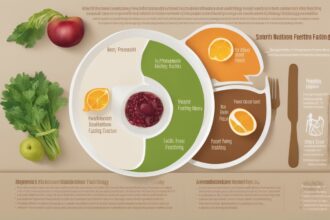fasting has gained immense popularity as a powerful tool for weight loss, mental clarity, and overall wellness. Whether you’re practicing intermittent fasting, extended water fasting, or a religious fast, one critical aspect often overlooked is the refeeding process. Knowing how to refeed properly is essential to avoid discomfort, health risks, and undoing the benefits of your fast. In this comprehensive guide, we’ll explore refeeding strategies that prioritize safety and effectiveness, blending practical advice with scientific insights. Let’s dive into how to transition back to regular eating with ease and confidence, ensuring your body reaps the rewards of your fasting journey.
What Is Refeeding and Why Does It Matter?
Refeeding is the process of reintroducing food to your body after a period of fasting or severe calorie restriction. During a fast, your digestive system slows down, and your body shifts to alternative energy sources like stored fat. If you jump straight back into heavy meals, you risk overwhelming your system, leading to bloating, nausea, or even a dangerous condition called refeeding syndrome. Understanding how to refeed safely helps prevent these issues and allows your body to adjust gradually. This isn’t just about eating again—it’s about nourishing your body strategically to maintain the benefits of fasting, such as improved insulin sensitivity and cellular repair.
Understanding Refeeding Syndrome: A Critical Risk to Avoid
One of the most serious concerns when learning how to refeed is the risk of refeeding syndrome. This potentially fatal condition occurs when electrolytes like potassium, magnesium, and phosphate drop dangerously low due to a sudden intake of carbohydrates after prolonged fasting. It’s most common in individuals who’ve fasted for over five days or are malnourished. Symptoms include weakness, confusion, and heart irregularities. Research shows that a gradual increase in calories and careful monitoring of nutrient intake can significantly reduce this risk. Always consult a healthcare professional if you’ve fasted for an extended period or have underlying health conditions before starting your refeeding plan.
Key Principles for Safe Refeeding After Fasting
When figuring out how to refeed after fasting, following a few core principles can make all the difference. First, start small—your digestive system needs time to “wake up.” Second, prioritize nutrient-dense, easily digestible foods to avoid shocking your system. Third, hydrate well, as water helps with digestion and nutrient absorption. Lastly, listen to your body. If you feel discomfort, slow down. Refeeding isn’t a race; it’s a deliberate process to restore balance. Below are some actionable guidelines to help you ease back into eating with a focus on recovery and wellness.
- Start with liquids: Begin with bone broth, vegetable broth, or diluted fruit juices to gently reintroduce nutrients.
- Focus on small portions: Eat small, frequent meals rather than large ones to avoid overloading your stomach.
- Choose simple foods: Opt for cooked vegetables, soft fruits, and lean proteins that are easy to digest.
- Avoid processed foods: Steer clear of sugary snacks or heavy fats that can cause digestive distress.
- Monitor your body: Pay attention to how you feel after eating and adjust portion sizes or food types accordingly.
Refeeding Strategies Based on Fasting Duration
The approach to how to refeed varies depending on the length of your fast. A 16-hour intermittent fast doesn’t require the same caution as a 7-day water fast. For shorter fasts (under 24 hours), you can often resume normal eating with lighter meals to start. For fasts of 1–3 days, a 1–2 day refeeding period with broths, soups, and soft foods works well. For extended fasts (over 3 days), plan a refeeding phase that lasts at least half the duration of your fast. For example, after a 10-day fast, spend 5–7 days slowly increasing calorie intake. Start with 20–30% of your usual calories and build up gradually, focusing on balanced macronutrients.
Best Foods to Include in Your Refeeding Plan
Choosing the right foods is a cornerstone of learning how to refeed effectively. The goal is to provide your body with gentle, nourishing options that support recovery without causing stress. Studies suggest that foods rich in electrolytes, vitamins, and minerals are ideal during the initial refeeding phase. Additionally, incorporating gut-friendly foods can help restore healthy digestion after fasting. Here’s a list of top foods to prioritize as you ease back into eating, ensuring a smooth transition for your body.
- Bone broth: Packed with collagen and minerals, it soothes the gut and provides hydration.
- Cooked vegetables: Steamed carrots, zucchini, or spinach are gentle on the stomach and nutrient-rich.
- Soft fruits: Bananas, applesauce, or melons offer natural sugars and potassium for energy.
- Lean proteins: Small amounts of chicken, fish, or eggs help rebuild tissue without overloading digestion.
Common Mistakes to Avoid During Refeeding
Even with the best intentions, it’s easy to make mistakes when learning how to refeed after a fast. One common error is eating too much too soon—your stomach shrinks during fasting, and overeating can cause pain or vomiting. Another mistake is consuming high-sugar or processed foods, which can spike blood sugar and lead to energy crashes. Additionally, neglecting hydration or ignoring symptoms like dizziness can derail your recovery. Take it slow, stick to a structured refeeding plan, and don’t hesitate to seek advice from a nutritionist if you’re unsure about your approach to post-fasting nutrition.
As you embark on your journey to master how to refeed, remember that patience and mindfulness are your greatest allies. Refeeding isn’t just about ending a fast—it’s about honoring the hard work your body has done and setting the stage for sustained health. By starting with small, nutrient-dense meals, staying hydrated, and listening to your body’s signals, you can transition smoothly back to regular eating. Whether you’re a seasoned faster or new to the practice, these refeeding strategies will help you avoid pitfalls and maximize the benefits of fasting. Have you tried refeeding before? Share your experiences or questions below—I’d love to hear how you’ve navigated this crucial step in your wellness routine!






